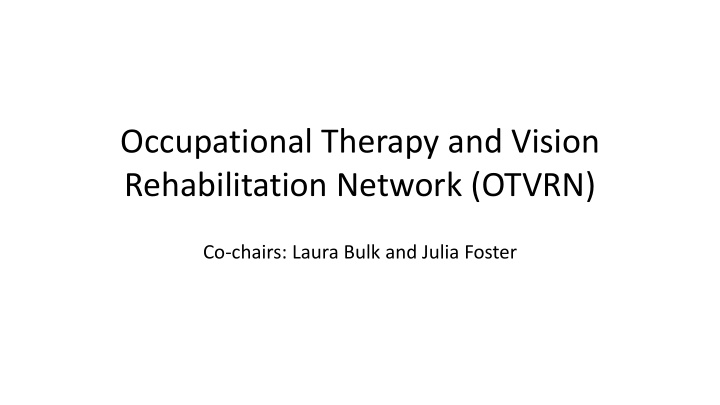



Occupational Therapy and Vision Rehabilitation Network (OTVRN) Co-chairs: Laura Bulk and Julia Foster
Context • Canadian prevalence: 5.7% (higher with age) • Affects participation, independence, safety – Loss of occupations, roles, meaningful activity – Higher falls (2x), hip fractures (4x), depression rates (3x) – Isolation – 1/5 housebound, 1/3 do not feel safe leaving home) – Lower graduation and employment rates – Lower income • Multiple comorbidities (85.7% have TWO comorbidities) Alijied et al 2018; Girdler et al 2008; Stats Canada, 2020; Stelmack, 2001; Sharma et al., 2002
Where does OT fit in? • Need for vision rehabilitation services is growing – More OTs working on vision rehabilitation teams • Need for collaboration is growing (i.e., complex needs) • Need to provide accessible services that consider vision loss *** Affects OTs across practice areas ***
OTVRN Vision All Canadians with vision loss will have equal access to quality occupational therapy services, both in the area of vision rehabilitation and other areas of practice. Mission Occupational therapists will make a substantial contribution to the lives of Canadians who are blind or partially sighted through education, research and advocacy.
OTVRN Activities
Engage Ongoing and upcoming network initiatives • Vision rehabilitation in the curriculum • Clinical practice group/journal club • Various research and resource development initiatives We want to hear from you! Email us if you want to get involved!
Learn CAOT Virtual Conference – Friday, May 8th: • Assistive technology and age-related vision loss: A critical discourse analysis • Use of supports by persons with age-related vision loss • Occupational Therapy and Vision Rehabilitation Network Archived (available) webinars: • Working with clients with vision loss: Introduction for all OTs (CAOT) • Technology for Older Adults with Age-Related Vision Loss (ARVL): What Do OTs Need to Know? (CAOT) • Power Mobility for People With Vision Loss (OSOT) And more!
Connect with us! To find out more about the network, share your initiatives, or sign-up for updates, contact the network chairs: ◦ Julia Foster : julia.foster@kingstonhsc.ca ◦ Laura Bulk : Lbulk@mail.ubc.ca, @LYBOT On the CAOT website: https://www.caot.ca/site/pd/otn/otlvrn?nav=sidebar
References Girdler, S., Packer, T.L., & Boldy, D. (2008). The impact of age-related vision loss. OTJR: Occupation, Participation and Health, 28(3), 110-120. Rumaisa Aljied, Jarie-Josee Aubin, Ralf Buhrmann, Samma Sabeti, Ellen Freeman, Prevalence and determinants of visual impairment in Canada: cross-sectional data from the Canadian Longitudinal Study on Aging, Can J Ophthalmol, 2018; 53:3;291-297 Statistics Canada. (2020). Canadian Survey on Disability 2017. Sharma, S., Brown, G. C., Brown, M. M., Hollands, H., Robins, R., & Shah, G. K. (2002). Validity of the time trade-off and standard gamble methods of utility assessment in retinal patients. British journal of ophthalmology, 86(5), 493- 496. Stelmack, J. (2001). QoL of low-vision patients and outcomes of low-vision rehabilitation. Optometry and Vision Science, 78(5), 335-342. doi:10.1097/00006324-200105000-00017 Images: 422737. (2014). Retrieved from https://pixabay.com/en/team-table-playmobil-round-table-451372/ Gotcredit. (2015). Education Keyboard Button. Retrieved from https://commons.wikimedia.org/wiki/File:Education_key_keyboard.jpg PDPics. (2013). Retrieved from https://pixabay.com/en/research-find-loupe-search-390297/ Youngson, N. (2008). Advocacy. Retrieved from http://www.thebluediamondgallery.com/wooden-tile/a/advocacy.html
Recommend
More recommend